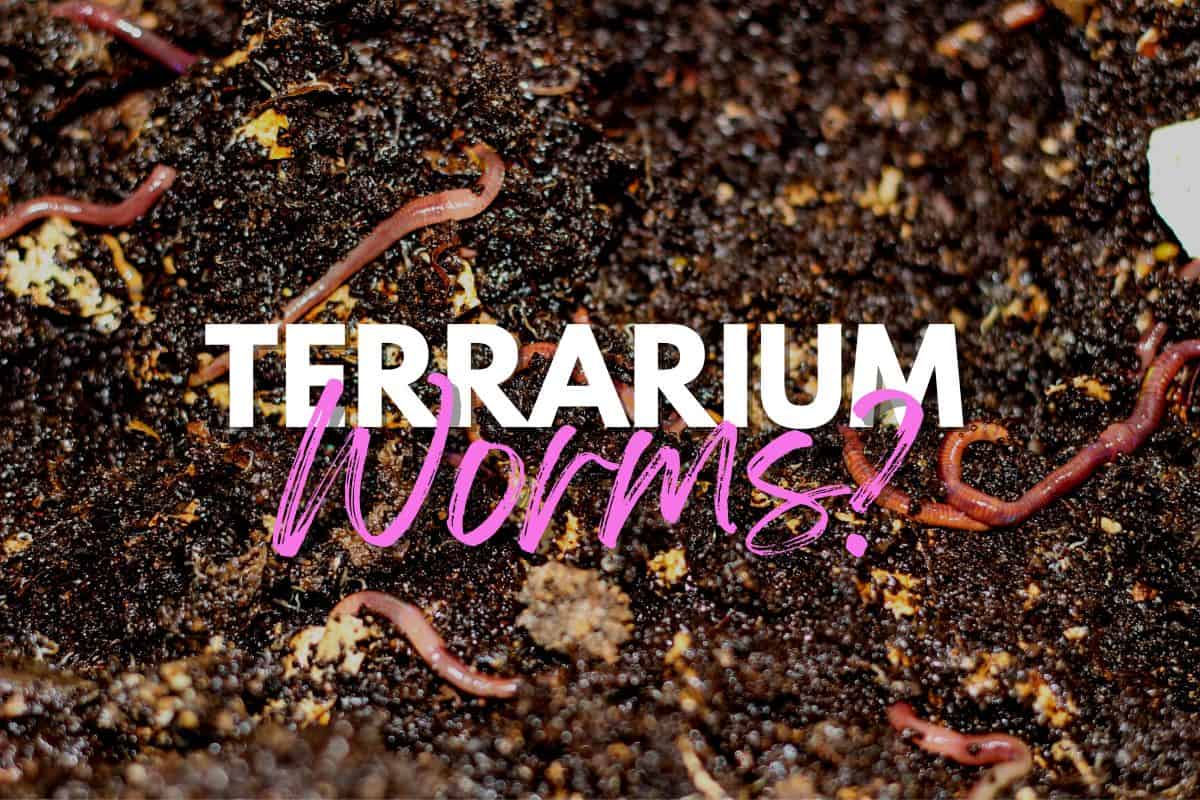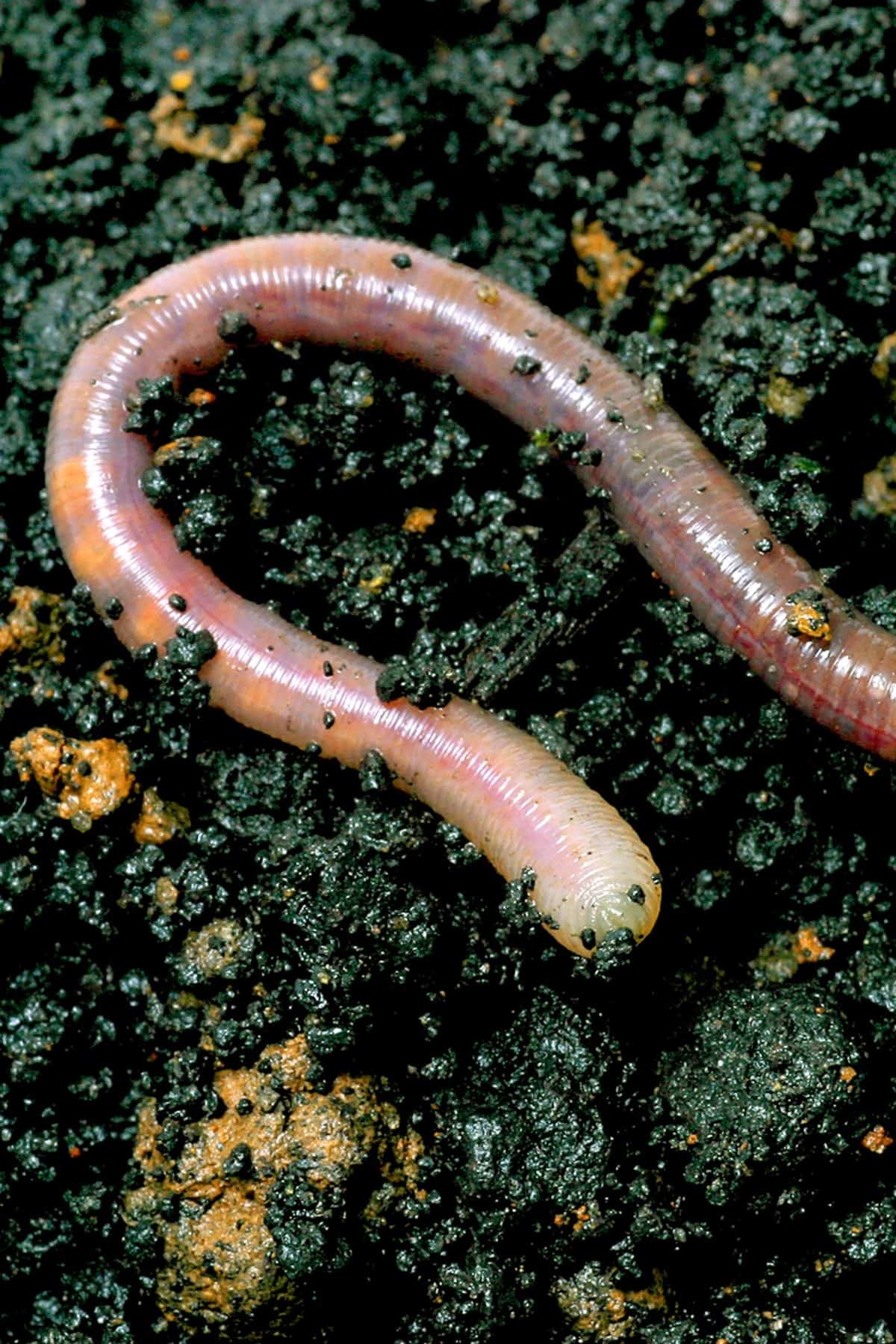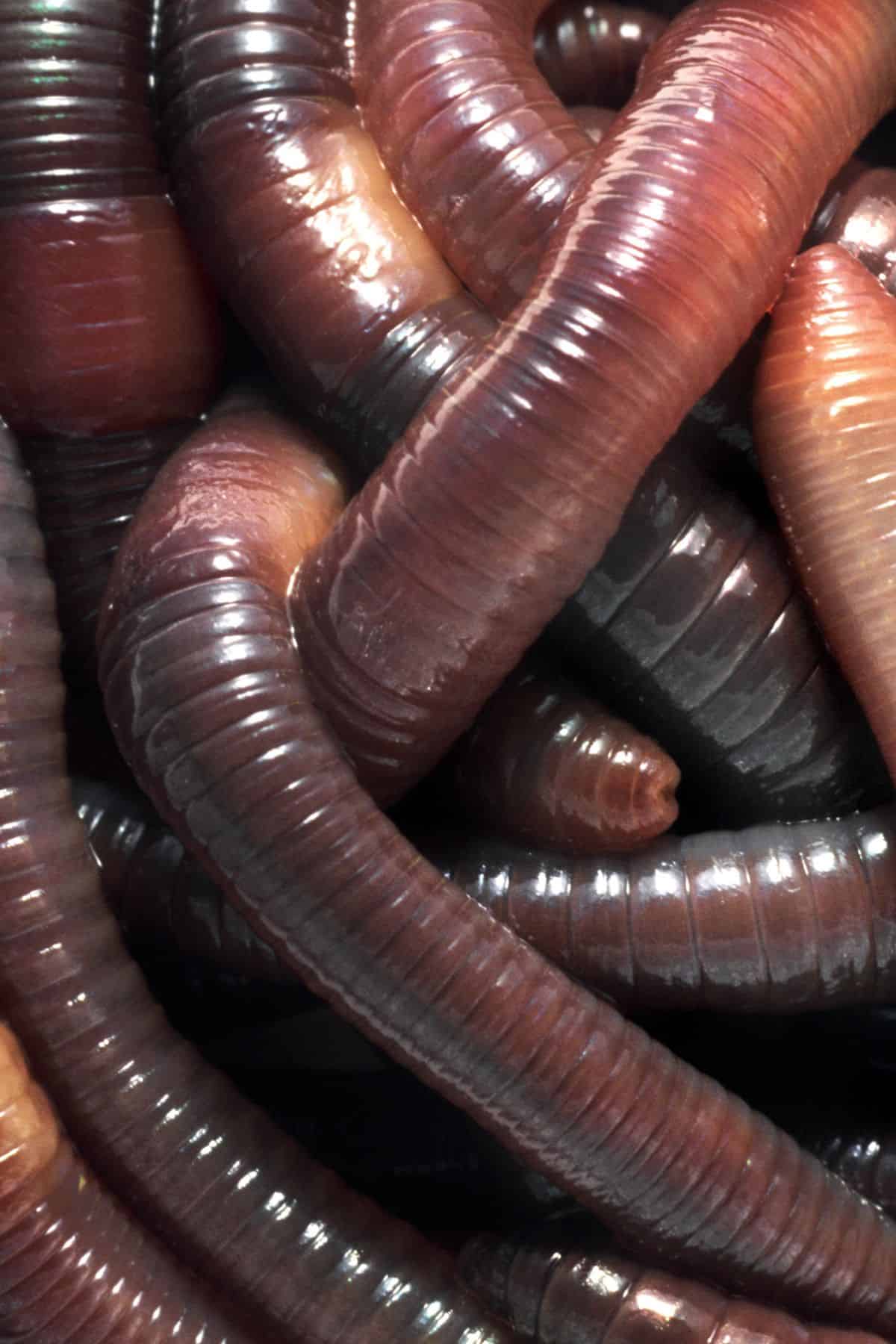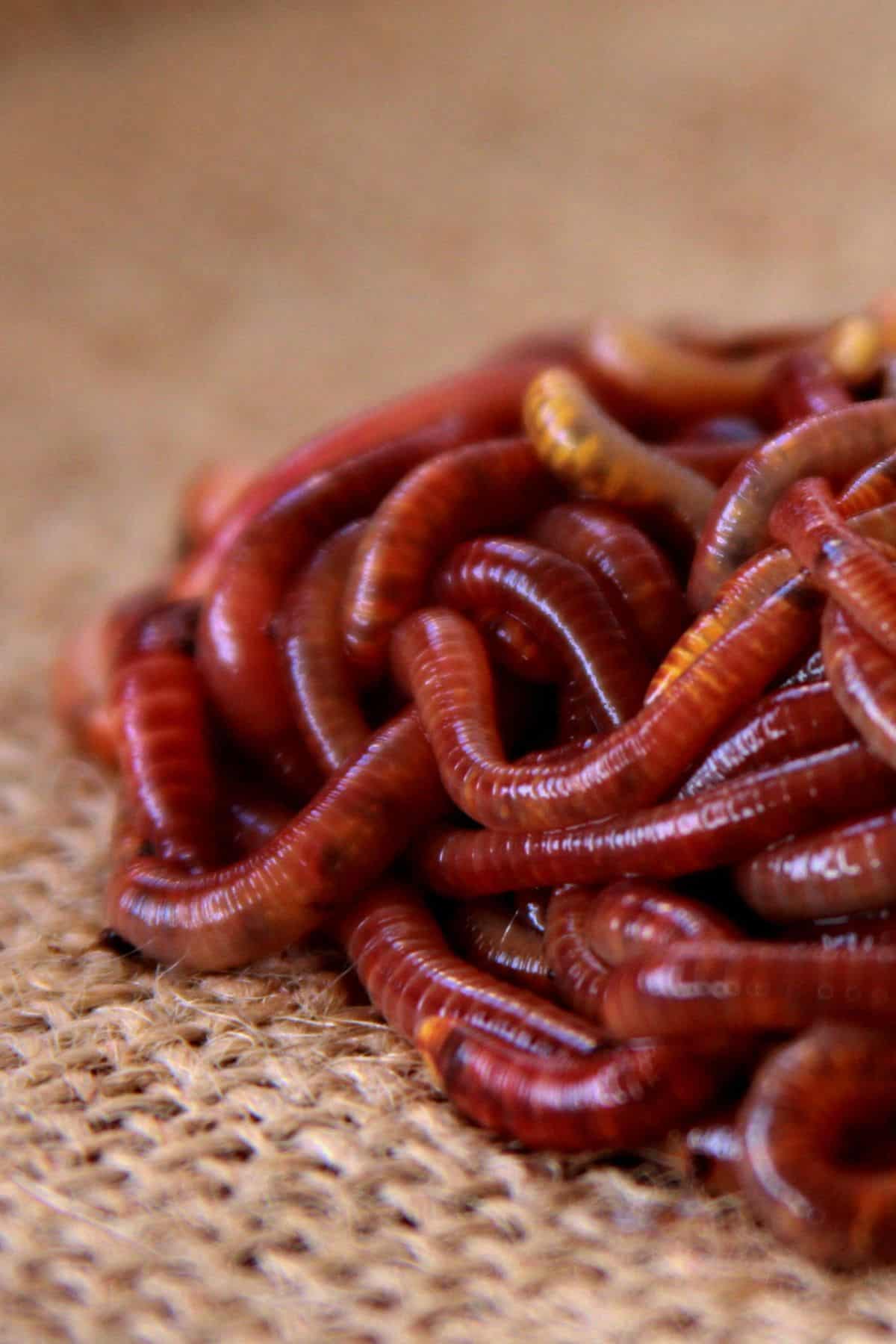Worms are one of nature’s best cleaners.
Hungry, wiggly powerhouses that can make short work of any waste organic matter. Seems like a great fit for a bioactive terrarium, right?
Well, you’d be right – but with some important caveats.
Earthworms, in particular, can be a double-edged sword, but there are a variety of worms to consider (from nematodes to nightcrawlers). So buckle in for a terrarium worm deep dive.
Let’s dig in!

Terrarium Tribe is reader-supported. When you purchase through links on our site, we may earn an affiliate commission (at no further cost to you). 💜
Are Earthworms Good for Terrariums?
Earthworms seem like a natural choice for terrariums.
“Terra” means “earth,” after all. Plus, the fact that you can go dig some up makes them an attractive proposition for terrarium projects (especially those on a budget).
But not all earthworms are created equal.
In fact, the term “earthworm” is a general term for a lot of different worms. Many of these terms are seemingly used interchangeably, too, so bear with me!
In this section, we’ll cover the pros and cons of earthworms in terrariums and then examine some of the differences between individual species.
Pros
- Earthworms tend to be effective bioactive cleaners. They’ll make short work of any decaying organic matter.
- They provide nutrient-rich fertilizer through their poop (known as worm castings).
- Through their burrowing action and movement, they aerate the soil to a very high degree – perhaps more than any other bioactive terrarium insect – which can benefit plants.
- Earthworms are pretty inconspicuous compared to other bioactive critters, which can be a good thing if you like a hidden cleanup crew.
Cons
- They often need a deeper substrate than I’d recommend for a typical terrarium.
- Unfortunately, earthworms will often feed heavily on the substrate itself. So, you’ll be refreshing your substrate a lot more often.
- They make a mess. They’re reportedly such voracious eaters that they end up turning the substrate into a thick “sludge” over time (and they get it up the glass, too).
- Worms can be indiscriminate eaters, and whilst they primarily eat decaying organic matter, they can also feed on live plant roots.
1 | Common Earthworms

First up, the most common earthworms.
Worms of the Lumbricus family are widespread and likely in your garden right now, but sadly, they aren’t the best terrarium candidate.
- They tend to be on the larger side (up to 15cm in length). Giants like that aren’t going to have much space to move around in a small terrarium.
- Many common earthworm species are deep borrowers (like several feet deep) and won’t thrive in a shallow terrarium environment.
Chances are, common earthworms are not going to be a good fit.
That’s why we’ll turn our attention to the most popular composting worms next.
We’ll look at some more specific species and their uses.
2 | Nightcrawlers

Nightcrawlers are similar to earthworms but have some distinct differences.
They are characterized by their dark purple coloration (hence the name) and their particular feeding/living patterns that make them useful in a worm composting bin.
There are various types, but they’re mostly clarified as the African and European counterparts are commonly used in composting, but we’ll judge how that might translate to a terrarium setting.
- Nightcrawlers are relatively small. Usually sizing up around a couple of inches long, they’re a much more terrarium-appropriate size.
- They’re nocturnal, so they’re an even more stealthy cleanup crew.
- Unlike common earthworms, nightcrawlers prefer to eat plant and animal waste (rather than the substrate itself). So, they’re more selective cleaners that will help your substrate last much longer.
- Though they can burrow deep, they tend to stay in shallow soil areas.
All in all, nightcrawlers seem like a much better fit for terrariums. However, large tank-style terrariums (potentially even with animal inhabitants) would make the best use of them.
3 | Red Wigglers / Red Worms

Well, Red Wigglers certainly have the best name as far as I’m concerned.
Eisenia foetida is one of the most common compost worms on the market. So they must have something going for them, right?
Let’s see.
- Red Wigglers are voracious eaters – they’ll eat just about anything (and at a rapid rate).
- They’re very adaptable and prefer higher temperatures. Both of which are excellent qualities for terrariums.
- Red Wigglers are surface dwellers. They don’t really burrow and like to live in the shallow soil layers.
- They’re similar in size to nightcrawlers, just a couple of inches long.
While Red Wigglers certainly seem like solid composting worms, they might be a little too effective for terrariums. If they rapidly consume your substrate (along with your leaf litter), they’re potentially doing more harm than good.
Nematodes in Terrariums
Nematodes are an incredibly diverse family of worms.
From small worms just a few centimeters in size down to microscopic species. They range from herbivores, bacterivores, fungivores, omnivores, and even predators.
So, to answer the question, “Are nematodes good for terrariums?”
Well, it depends.
Usually, people ask because they find tiny white worms in their terrariums, which I can see coming as a shock! However, these are likely soil nematodes; they’ll sometimes appear unannounced in a terrarium (presumably from egg-infested substrates).
We’ll cover the pros and cons of nematodes, but bear in mind that every species is different.
- Bacterivore and fungivore species can be beneficial in keeping bacterial and fungal/mold growth in check, respectively. However, herbivore nematodes can feed on plants and plant roots.
- Some parasitic nematode species will target terrarium pests in the shallow areas of the substrate. But if you’re keeping animals, parasitic nematode species could potentially threaten them.
In the wild, nematodes play a crucial role in soil health.
So, in a terrarium, I can see them being beneficial for nutrient cycling. I probably wouldn’t introduce them to a terrarium for this reason, but if they showed up there, I wouldn’t have a problem with it.
Plus, some parasitic species potentially have a use as biological pest control – particularly for soil-dwelling creatures like fungus gnats and aphids. So, on rare occasions, I might consider adding them.
Wrapping Up
So, it looks like terrarium worms are a pretty niche pick for a bioactive cleanup crew.
As you’d need a deep substrate layer (and you’ll have to change it semi-regularly), I’d argue worms are only really suitable for large tank-style terrariums that require a ton of cleaning and fertilizing.
In most cases, they’re hard to justify when pitted against the classic terrarium isopod and springtails combo, but they have some rare use cases. For most people, a springtails culture will be more suitable.
Have you used earthworms in terrariums successfully?
Let me know in the comments.

Hi Dan! I’m doing an experimental terrarium-wormhotel-combo using a lemonade dispenser, haha. Couldn’t find whether people tried that, it has some obvious risks that I try to circumvent in the design, but I thought: one way to find out if it is even remotely a good idea 😉
So, I wanted to feed kitchen scraps to worms, but as I try to keep my room as green as possible a closed wormhotel didn’t appeal too much. A wormhotel has a tap at the bottom to take out and repurpose the moist that comes from the worms, so a regular glass case was out of the question. A lemonade tap still as space beneath the tap which would become gross, so I am currently creating an epoxy filling that leads the moist straight to the tap. I’ll be putting a regular terrarium build on top of that, except I’ll leave a little space in the middle where I’ll be putting a cylindrical wormhotel, with a diameter of max 10cm (which is the size of the hole on top) and a height of 20-25cm, depending on how much space the substrate leaves me.
It’s a pretty small build so that’s obviously a big risk, hopefully the continuous food in the cylinder and finding smaller-sized worms will keep them happy and mostly away from the substrate. There’s also hige risk of moulding so I’ll be adding isopods and springtails as well to keep it all under control…….
Fingers crossed, maybe it will become a big nightmare, I will let you know 🙂
Sounds like a fun experiment 🙂 Keep us posted!
Did your experiment work? I’m curious because I want to conduct my own and any insight I could get would be extremely helpful.
Yes! I have used earthworms in terrariums successfully. I have a 1 litre jar closed terrarium. I have used creatures found in my compost. That includes isopods, one earwig and 3 earth worms. Also, mealworms added from a pet shop. The jar is now 3 weeks old (sealed for two weeks.) My earth worms are happy! Although I have noticed the small white worms (nematodes) have eaten one of my mealworms (bringing me to this post).